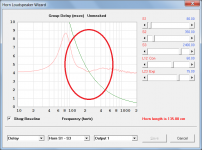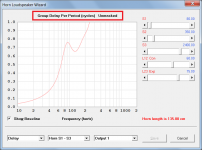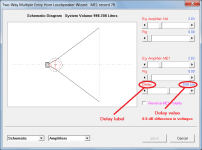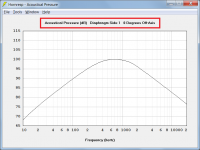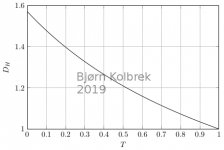For me it still works here, in wizard's delay chart.Hmm, I'm thoroughly confused.........just installed 190101 and double clicking in 'group delay' pops up the 'sample' window, one click pops up the red line that displays frequency and delay and no amount of clicking anywhere gets me a green line or period chart.
GM
Not in calculated group delay screen, but it wasn't before.
no amount of clicking anywhere gets me a green line or period chart.
Hi GM,
The functionality applies to the Loudspeaker Wizard only.
Kind regards,
David
Attachments
Ah! Thanks! Only read what was outlined in red and not too sharp nowadays after an 'all nighter'.
GM
GM
I cannot switch to time delay anymore with delay slider, no matter how many time i double click on "delay"
Hi Damien,
The switch functionality has not changed, only the slider limits.
Double-click the delay label to set the time-aligned delay distance in cm. It is only necessary to double-click the delay label if you want the slider to automatically adjust to the time-aligned distance.
Double-click the delay value to change the delay from distance to the equivalent time. Double-click the delay value again if you want to change the delay from msec back to cm.
The default distance of 12 cm in my previous example becomes 12/344 = 0.35 msec.
Kind regards,
David
Attachments
not too sharp nowadays after an 'all nighter'.
Still suffering from a self-inflicted New Year's Eve hangover, perhaps? 🙂.
I hope to post on the 1,000th page!
Me too, if I manage to survive until then 🙂.
I was so confident, my sincere apologiesHi Damien,
The switch functionality has not changed, only the slider limits.
Double-click the delay label to set the time-aligned delay distance in cm. It is only necessary to double-click the delay label if you want the slider to automatically adjust to the time-aligned distance.
Double-click the delay value to change the delay from distance to the equivalent time. Double-click the delay value again if you want to change the delay from msec back to cm.
The default distance of 12 cm in my previous example becomes 12/344 = 0.35 msec.
Kind regards,
David

OK question regarding SPL on an open baffle stimulation. Can I generate a directivity response some how. This is greyed out. I can do a power response with normal inputs and calculations. So I'm not that stuck. Just wondering the rational behind the no directivity option.
Just wondering the rational behind the no directivity option.
Hi Mark,
Hornresp cannot generate directivity responses for combined outputs - there are just too many unknowns. For your open baffle example, select Tools > Output > Diaphragm Side 1 (or Diaphragm Side 2) from the Acoustical Power chart window, then select Tools > Directivity > Response.
Kind regards,
David
Attachments
I was so confident, my sincere apologies
Hi Damien,
Not a problem - it's great that you are prepared to go actively looking for bugs in Hornresp!
Just to clarify, in my previous reply to you I indicated that 12/344 = 0.35 msec. While this ratio certainly calculates the time delay, it does not give the answer in milliseconds directly. It needs to be multiplied by 10 to do this. In other words, if the velocity of sound in air is 344 metres per second then the sound travels 12 cm in 12/(344*100) seconds or (12/(344*100))*1000 milliseconds. (12/(344*100))*1000 simplifies to (12/344)*10.
Kind regards,
David
Hi Mark,
Hornresp cannot generate directivity responses for combined outputs - there are just too many unknowns. For your open baffle example, select Tools > Output > Diaphragm Side 1 (or Diaphragm Side 2) from the Acoustical Power chart window, then select Tools > Directivity > Response.
Kind regards,
David
Will do that for sure. Thanks David.
Hi David - when fooling around with the DBR Wizard, I managed to get a cone excursion plot which didn't match what it should have been - (later it calculated the excursion like its single BR and DCR kin) - - also I did something in an order it didn't like several times which left a box empty. (sorry for being an idiot - so far hornresp might be foolproof - but not idiot proof)


Hi freddi,
Many thanks for this excellent feedback! You are not "being an idiot" - far from it 🙂. Hornresp simply should not do such things under any circumstances - there is something wrong somewhere.
It seems that you have identified two issues; firstly, that the diaphragm displacement is not what we would expect to see from a DBR system, and secondly, that it is possible to crash the wizard as you have shown. I have tried to replicate the problem you experienced, but so far without success. Would it be possible to provide details of the sequence of events that leads to the blank input drop-down list box being displayed? If I can generate the problem myself, then with a bit of luck I should be able to track down the cause and fix things.
Thanks and kind regards,
David
Many thanks for this excellent feedback! You are not "being an idiot" - far from it 🙂. Hornresp simply should not do such things under any circumstances - there is something wrong somewhere.
It seems that you have identified two issues; firstly, that the diaphragm displacement is not what we would expect to see from a DBR system, and secondly, that it is possible to crash the wizard as you have shown. I have tried to replicate the problem you experienced, but so far without success. Would it be possible to provide details of the sequence of events that leads to the blank input drop-down list box being displayed? If I can generate the problem myself, then with a bit of luck I should be able to track down the cause and fix things.
Thanks and kind regards,
David
Horn Nonlinear Distortion Revisited
Hi David,
Re: Beranek & Mellow pages 433-435
In the virtual equation 9.85a set P1 = PT*[cosh(m*x/2)+T*sinh(m*x/2)] and PT = [(It*ρ0*c)]^(1/2)
then equation 9.86 can be recast to cover the entire Salmon family of horns (Exponential Included), i.e.:
{50*(γ+1) / (γ*P0)}*{[(It*ρ0*c)/2)]^(1/2)}*{ƒ/ƒc}*{1–[1/[cosh(m*x/2) + T*sinh(m*x/2)]]
Regards,
Bill
Hi David,
Re: Beranek & Mellow pages 433-435
In the virtual equation 9.85a set P1 = PT*[cosh(m*x/2)+T*sinh(m*x/2)] and PT = [(It*ρ0*c)]^(1/2)
then equation 9.86 can be recast to cover the entire Salmon family of horns (Exponential Included), i.e.:
{50*(γ+1) / (γ*P0)}*{[(It*ρ0*c)/2)]^(1/2)}*{ƒ/ƒc}*{1–[1/[cosh(m*x/2) + T*sinh(m*x/2)]]
Regards,
Bill
equation 9.86 can be recast to cover the entire Salmon family of horns
Hi Bill,
Thanks for this.
The form of the recast equation is such that for fixed S1, S2 and L12, an increase in the value of T increases the distortion. Shouldn't an increase in the value of T decrease the distortion because the cross-sectional area near the horn throat is then expanding at a faster rate? I would have expected a catenoidal horn (T = 0) to have a higher distortion than an "almost conical" horn (T = 10). Am I missing something here, perhaps?
Kind regards,
David
I would have expected a catenoidal horn (T = 0) to have a higher distortion than an "almost conical" horn (T = 10). Am I missing something here, perhaps?
I went through the equations for Hypex horns for the book I'm working on, and a correction factor to the standard distortion equation that is valid for T<1 is
2{arctan((T+1)/R) - arctan(T/R)} / R
where R = sqrt(1-T^2).
This equation is plotted in the attached graph. Distortion for T=0 is about 57% higher than for an exponential horn.
(Bill, did you follow the procedure outlined by Beranek; differentiating (9.85, multiplying by how the pressure varies through the horn, and then integrating wrt x?)
Attachments
Eating Humble Pie
No! By inspection of pressure equations 9.42 (Exponential) and 9.54 (Hyperbolic) where the only the coefficients on the immediate right differ, I apparently leapfrogged my way into dum-dum land. Sorry guys and thanks for the correction. WHG
I went through the equations for Hypex horns for the book I'm working on, and a correction factor to the standard distortion equation that is valid for T<1 is
2{arctan((T+1)/R) - arctan(T/R)} / R
where R = sqrt(1-T^2).
This equation is plotted in the attached graph. Distortion for T=0 is about 57% higher than for an exponential horn.
(Bill, did you follow the procedure outlined by Beranek; differentiating (9.85, multiplying by how the pressure varies through the horn, and then integrating wrt x?)
No! By inspection of pressure equations 9.42 (Exponential) and 9.54 (Hyperbolic) where the only the coefficients on the immediate right differ, I apparently leapfrogged my way into dum-dum land. Sorry guys and thanks for the correction. WHG
Easy mistake to make, Bill, things look simple when you use the exponential function...
Some further comments to the equation. The limit as T->1 is 1. It is also valid for T>1, where both the numerator and denominator are complex, but the result is real.
As T increases, distortion decreases, but keeping the horn end dimensions and length the same, so does the cutoff frequency, and just looking at the correction factor can be deceiving.
Some further comments to the equation. The limit as T->1 is 1. It is also valid for T>1, where both the numerator and denominator are complex, but the result is real.
As T increases, distortion decreases, but keeping the horn end dimensions and length the same, so does the cutoff frequency, and just looking at the correction factor can be deceiving.
a correction factor to the standard distortion equation that is valid for T<1 is
Thanks Bjørn 🙂.
- Home
- Loudspeakers
- Subwoofers
- Hornresp
